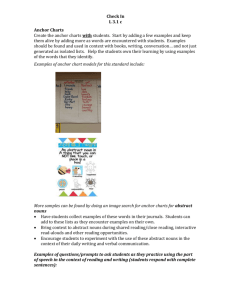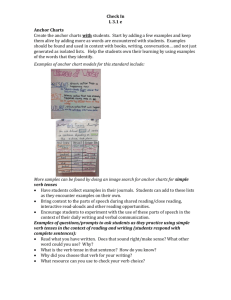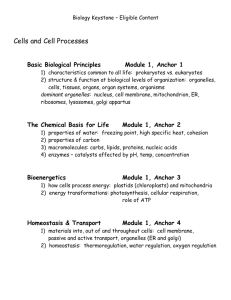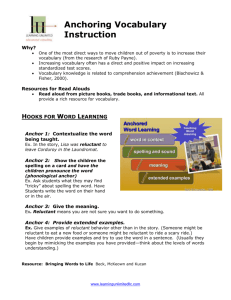Anchor Charts - the School District of Palm Beach County
advertisement
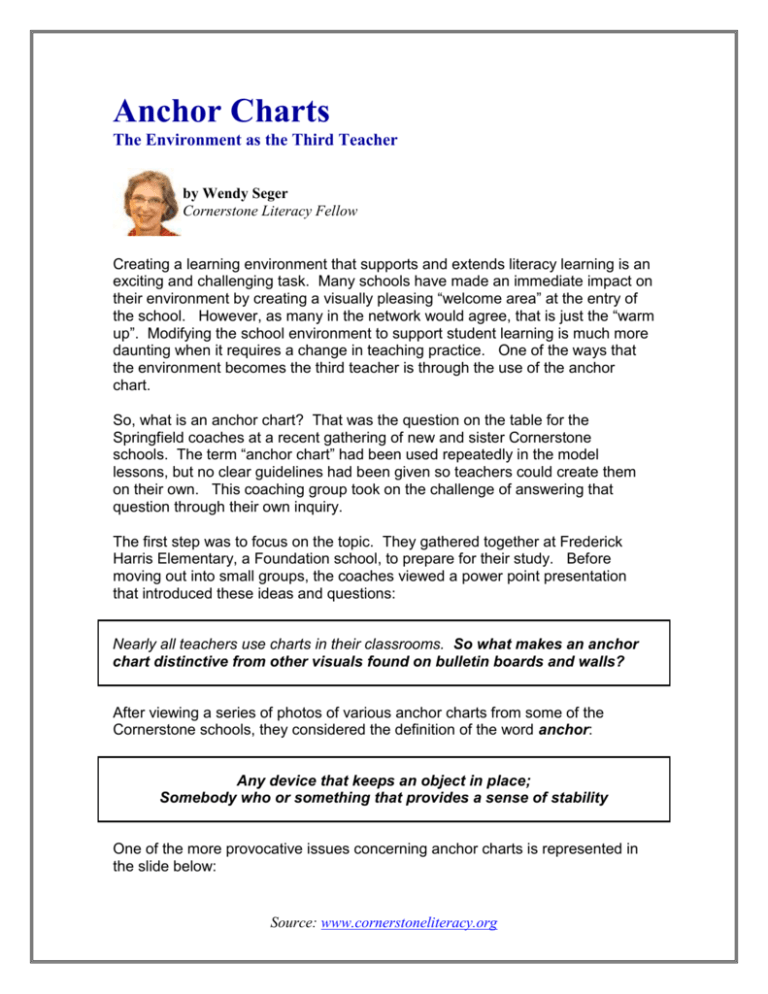
Anchor Charts The Environment as the Third Teacher by Wendy Seger Cornerstone Literacy Fellow Creating a learning environment that supports and extends literacy learning is an exciting and challenging task. Many schools have made an immediate impact on their environment by creating a visually pleasing “welcome area” at the entry of the school. However, as many in the network would agree, that is just the “warm up”. Modifying the school environment to support student learning is much more daunting when it requires a change in teaching practice. One of the ways that the environment becomes the third teacher is through the use of the anchor chart. So, what is an anchor chart? That was the question on the table for the Springfield coaches at a recent gathering of new and sister Cornerstone schools. The term “anchor chart” had been used repeatedly in the model lessons, but no clear guidelines had been given so teachers could create them on their own. This coaching group took on the challenge of answering that question through their own inquiry. The first step was to focus on the topic. They gathered together at Frederick Harris Elementary, a Foundation school, to prepare for their study. Before moving out into small groups, the coaches viewed a power point presentation that introduced these ideas and questions: Nearly all teachers use charts in their classrooms. So what makes an anchor chart distinctive from other visuals found on bulletin boards and walls? After viewing a series of photos of various anchor charts from some of the Cornerstone schools, they considered the definition of the word anchor: Any device that keeps an object in place; Somebody who or something that provides a sense of stability One of the more provocative issues concerning anchor charts is represented in the slide below: Source: www.cornerstoneliteracy.org Finally, the coaches set out to answer one essential question: What are the features of an anchor chart? They moved into the school in small groups with cameras and notebooks to collect data from the hallways and within the classrooms at Harris. The goal was to discover which features could be used to form a rubric that would help define and assess the charting done in each school setting. Upon the coaches’ return from their scavenger hunt, the photos were quickly downloaded and viewed with a critical eye for common characteristics and the contexts of use. It was from this analysis that they were able to recommend a list of features that would define a good anchor chart: 1. An anchor chart should have a single focus. Sometimes a teaching standard is broad by design, such as Students will write with a clear focus, coherent organization, and sufficient detail. (MA ELA #19). To be able to meet this standard, teachers would have to help students accomplish the many more discrete skills that build capacity to meet this writing expectation. Those discrete skills make up the topics of the crafting lessons that are taught in the day-to-day work within the reader and writer’s workshop. It is those discrete skills that are represented in an anchor chart. For example, the anchor chart to the right supports the learner in one of the skills that would lead toward mastery of the aforementioned standard. 2. The anchor chart is co-constructed with the students. The brainbased research of Marcia Tate and others support the use of visuals to incorporate new learning into memory. When the visual represents a Source: www.cornerstoneliteracy.org learning event that includes the students, it becomes an artifact of the learning experience. It has meaning for the students because they participated in its construction. One could think of it in terms of food: The cookies taste better when you help make the dough. 3. The anchor chart has an organized appearance. The importance of clarity is paramount to understanding. If the students can’t read the chart or find the statement of explicit instruction (Where’s the WILF?), the chart will be of no support to the students when they return back to the chart as a scaffold. 4. The anchor chart matches the learners’ developmental level. The language, the amount of information, the length of the sentences, and the size of lettering should all match the cognitive level of the students for whom the chart will serve. Following this explanation, there are two anchor charts created for the same lesson: introduction to the comprehension strategy of schema. The one on the left was designed for second graders, the one in the middle for fourth graders, and the one on the right for first graders. Notice the differences in language and complexity. 5. The anchor chart supports on-going learning. One of the most important considerations for learning is whether or not the chart is relevant and used by the students. Charts should reflect recent crafting lessons or concepts that need continued scaffolding. Teachers can support learning by placing an anchor chart in a classroom library where students can access the information when they are making their literature responses during and after independent reading. It is within this feature that the coaches felt a commercial chart could indeed be an anchor chart, provided that there was evidence that the students were actually using the chart. With the recommendations completed, the features were placed into a table, creating a useable tool for generating and assessing anchor charts in each building. Source: www.cornerstoneliteracy.org The work from this cadre of coaches is not meant to be definitive on the subject of anchor charts. In fact, the hope is that their work will start the discussion in the Cornerstone network about this significant element of the classroom environment. If any readers are interested in sharing their insight or expressing a viewpoint about the use of anchor charts, please join an online discussion occurring at the Cornerstone web log found at: http://blog.cornerstoneliteracy.org/wendy/, listed under Cornerstone Colleagues: What is an Anchor Chart? Happy Charting! Anchor Chart Rubric: Apparent Not Apparent A single focus Co-constructed with students Organized appearance Matches learners developmental stage Supports on-going learning Source: www.cornerstoneliteracy.org Comments


